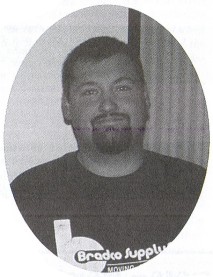Hemingray Carnivals
Reprinted from "Crown Jewels of the Wire", September 2001, page 11
Display by:
Bob Stahr
11728 Leonardo Drive
Saint John, IN 46373-9448
219-365-4171
bob@hemingray.com
WINNER:
1st Place N.I.A. Color

What is carnival glass?
Basically, carnival glass is regular glass that has
been sprayed with a metallic oxide while the insulators were still warm from the
molds. This metallic oxide is slightly conductive and was used to help reduce
radio interference from the power lines. These carnival insulators were also
used for low leakage by making the insulator slightly resistant. (See the
Western Union Specifications below.)
Fifteen different CD styles, most used in
known installation applications and several specimens which have only been found
in a Hemingray dump, are displayed along with four different carnival bottling
products made by Hemingray.
|
THE WESTERN UNION TELEGRAPH COMPANY
ENGINEERING DEPARTMENT |
PROVISIONAL
SPECIFICATIONS
2162-A
March 16, 1935 |
PROVISIONAL SPECIFICATIONS
FOR
THE INSTALLATION OF LOW VOLTAGE INSULATORS
(TS-2)
PURPOSE AND DESCRIPTION: The purpose of the TS-2 Insulator is to provide a
greater resistance to leakage than is obtainable from our present standard
double petticoat insulator. This is done by treating the surface of the
insulator to make it highly resistant and then protecting a portion of the inner
surface against dirt.
The protection is afforded by the metal insert or bushing
which is screwed tightly into the lower part of the insulator. As can be seen
from the accompanying drawing, the bushing clears the cob and pin and is in
contact with the insulator only at the threaded portion. Behind the upper part
of the bushing is a dead air pocket into which dirt particles enter only with
difficulty. As long as this surface remains reasonably clean the high insulation
should be maintained.
INSTALLATION: These insulators may be handled and mounted
in the same way as our standard insulator. However, the following precautions
for insuring a good installation should be taken:
- In handling these insulators and in distributing them along the
railroad right of way, care must be taken to avoid subjecting them to
dirt, mud, water or any other contamination.
- They must not be mounted on split or broken cobs or on pins upon
which long scales of rust have formed. If defective cobs or pins in
poor condition are encountered, they should be replaced.
- If existing cobs are fit for reuse, they should be cleaned of
splinters, cocoons or other matter adhering to or projecting from
them. A film of dirt on a cob, unless of unusual thickness is not
objectionable.
- Before each insulator is mounted, the lineman should carefully
examine the inside to see that no dirt, twigs, straws or other foreign
matter has collected which would bridge between the bushing and cob
and thus short out the protected path.
- If by accident or otherwise a bushing becomes loose in an insulator,
it should be tightly screwed back.
- No cracked insulators shall be used. If found they shall be
discarded and the bushings salvaged.
|
(Information compiled by Bob Stahr for display
handout.)

Hemingray Color by Bob Stahr
1st Place N.I.A. Color

INSULATORS: CD 230 Broken aqua with remnants of carnival coating dug at
Hemingray factory site, Muncie, IN; CD 297 Hemingray-72 was once
carnivalized; CD 281 Hemingray-71, CD 262 IIcmingray-62 -all specimens from Hemingray
dump sites.

CD 2B2 An unusually dark Hemingray D-513 with original brass bushing from Hemingray dump; CD
154 Hemingray-42 is a darker example than most. A grouping
of these were found on a railroad line in northwest Indiana, most of them were
quite dirty and hard to clean; CD 118 is unembossed and was originally outfitted
with a large copper skirt that threaded itself onto the outer surface of the insulator,
very few of which have survived; CD 142.4 Hemingray TS-3 has a glass bushing cemented inside of the insulator
which was also sprayed with carmival.
More common styles of Hemingray carnival included in this display: CD 168, CD 230; CD 162
Hemingray-19 signals which were installed in the Hutchinson,
Kansas area; CD 1052 Hemingray D-518 rack spool; CD 164 Hemingray-20
signals in a lighter coating of carnival were prevalent in Ontario, Canada; CD 142
Hemingray TS-2 was manufactured with a threading on the inside of the outer skirt to
accept a copper bushing.
Just to the right of the name card at the left of the display are shards
which I believe to be a made-for-export insulator. The threading and general
style of insulator does not seem to coincide with any of the TS series.
BOTTLES:
- Ginger Ale Bottle: Unembossed, but stippled surface design, mold number and a raised dot on the bottom are typical of
Hemingray bottles. 2
known.
- Universal Home Bottle: patented on June 2 1931 by Hemingray
employee Willard P. Zimmerman. Measuring lines down the side of the bottle
indicate it was probably used for household measuring purposes. 6 carnivals
known.
- Hammers: This 7-up colored bottle is carnivalized. The bottle embossed
"Hammers Bubbles of Health" depicts a little champagne glass on the
bottle. Shards were found al the Hemingray factory site. Hammers was a bottler
from New York. 3 known.
- Sun Punch: Patented by Ben Domont of Indianapolis, IN on
February 9, 1931 and used by Monument Bottling Co. of Indianapolis to bottle
sun punch in a "bottle pitted and orange colored similar to the surface of
an orange. Shards found at Hemingray factory site. Over 10 known.
|
